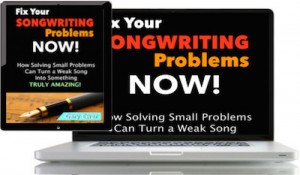When we talk about musical energy or momentum, we’re often talking about how loud, quick or rhythmically complex a song is. We think of songs that have energy as songs that get us moving.
But in fact, energy is more complicated than that. All songs have energy, even the very quiet, slow ballads that are lightly orchestrated. An example might be Julia Michaels’ “Issues” (Michaels, Levin, Hermansen, Eriksen, Tranter). There’s not a lot of change over the entire length of that song, but energy is an important part of why that song works.
 “Fix Your Songwriting Problems – NOW!” puts the spotlight on seven of the most common errors songwriters typically make, and then offers some quick solutions you can try.
“Fix Your Songwriting Problems – NOW!” puts the spotlight on seven of the most common errors songwriters typically make, and then offers some quick solutions you can try.
Musical energy is generated in many ways, but it’s best to start by thinking about what it does as a way of letting us know what it is.
Musical energy is the main aspect of what keeps us interested in listening to a song. A song with a properly constructed sense of energy makes us feel that something even more interesting is about to happen, and it makes it easy to stick with it.
Musical energy is an area of great concern for a producer. The producer, along with the songwriter, tries to find the best way to entice listeners to keep listening. They do this by applying the contrast principle, which means finding ways to allow musical energy to build up, and then allow it to dissipate.
This up-and-down, ebb-and-flow aspect of musical energy is vital to keeping audiences interested. For producers, they’ll do any of the following:
- Plan an instrumental and vocal approach for the song.
- Suggest modifications to the chords to build up and release musical energy.
- Suggest changes to the melody (or take on the responsibility of rewriting the melody in various sections).
Good producers do a lot more than that, but when it comes to the recording of the music, their primary concern is to entice listeners to keep listening.
A Song’s Natural Energy Shape
One of the most important things that you as a songwriter can do is to write your song in such a way that it requires minimal support from the producer. Here’s what I mean by that:
Most songs will start with a relatively low feeling of musical energy when compared to the song as a whole. That’s what we usually pick up when we compare a verse and a chorus. A bridge often serves as a contrast for the overall energy level of a song: a very exciting song might use the bridge as a way of allowing for energy to ebb. Or it might offer even more energy.
As the writer of the song, there are things you can do to ensure that these fluctuations in musical energy are happening as a feature of the way the song is written.
For example, if your verse and chorus both sit in the same melodic range, and both use similar rhythms, and the chorus therefore fails to deliver any sense of “punch”, the missing punch can be delivered by the producer creating an instrumental plan that makes the chorus sound more exciting.
And though a good producer should do that, it’s important that choruses sound more energetic than verses as a feature of the way the song was written in the first place.
In other words, a good song should display all the kinds of things a producer might do, even before the producer gets their hands on it. That’s what I mean by requiring minimal support from the producer. It’s better if the producer’s instrumental approach is supporting aspects already present in the music.
Singing Your Song Unaccompanied
One of the best ways to ensure that you’ve got a properly constructed song is to sing it a cappella — with no accompanying instruments — and see if the song works that way. Any song with a melody should be able to work this way.
It doesn’t mean that a song will always sound best when performed this way, but it does mean that you should be able to hear all of the necessary rises-and-falls of musical energy, both real and implied, as your melody rises and falls.
Musical energy will also be influenced by the words you sing, so you need to also pay special attention to your song’s lyric.
In any case, having musical energy rising and falling needs to be present in the very way you’ve written the music. Don’t wait for whatever a producer might do — get it working in the bare-bones version of your song before you take it to the recording studio.
 Written by Gary Ewer. Follow Gary on Twitter
Written by Gary Ewer. Follow Gary on Twitter
If you’re ready to study — to learn why a great song succeeds — and then to apply those discoveries to your own songs, you’re ready for “The Essential Secrets of Songwriting 10-eBook Bundle”










